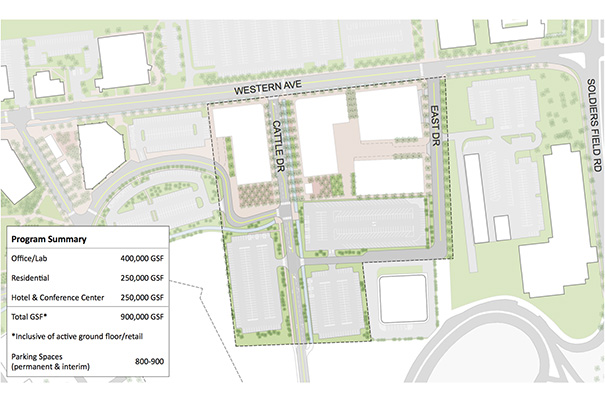Harvard files Allston plan
Enterprise Research Campus envisioned as regional innovation hub
Harvard University launched the initial development phase of a new regional innovation hub on Thursday with the filing of regulatory plans for the Enterprise Research Campus (ERC) in Allston.
Harvard’s vision for the ERC involves myriad uses, including as a location for private businesses, nonprofit organizations, incubators, startups, and social enterprises pursuing opportunities for applied research and entrepreneurship.
The plan also envisions the ERC as a home to both residential units and a hotel and conference area. The area is intended to generate and implement new and innovative ideas to improve the world in practical and tangible ways, and to foster new levels of collaboration among students and faculty, academic communities and their counterparts in the private sector, entrepreneurs and investors, and local companies and global entities.
The University, which filed a detailed Planned Development Area (PDA) Master Plan with the Boston Planning and Development Agency, says the ERC presents an unparalleled opportunity to enhance the power of collaboration among the area’s academic institutions, hospitals, and research-based industries, and to profoundly impact the regional economy.
The 36-acre site is across the street from Harvard Business School (HBS), the i-lab, the Launch Lab, and the Life Lab, and will be near the new Artlab, which is in the permitting process. The site is also adjacent to the new Science and Engineering Complex that will house the Harvard John A. Paulson School of Engineering and Applied Sciences (SEAS), and is scheduled to open in the fall of 2020.
“The Enterprise Research Campus holds the promise to bolster the remarkable strengths of Harvard and the Greater Boston region in the life sciences and in areas such as bioengineering, imaging, and robotics,” said Harvard President Drew Faust. “Bringing those strengths together at the center of one of the most innovative research areas in the country will help generate new insights that will improve the world in practical and tangible ways, and inspire collaboration and creativity that will launch some of the most extraordinary ideas, careers, and companies of the century.”
In Harvard’s 2013 Institutional Master Plan, the ERC was described as an area that would “include flexible and adaptable facilities that can accommodate changing research requirements and paradigms” under principles that sought to “create a dynamic blend of activity that will make the area a sought-after destination — a place where companies want to locate, and a place where people want to work.”

The University operated under a core set of guiding principles when considering the planning framework for both the broader 36-acre ERC area and the initial 14-acre PDA Master Plan area. It envisioned creating a livable urban district with a synergistic mix of uses, an active and vibrant area with open and green spaces. The development master plan considers the near-future transportation infrastructure, storm water and utility connections, and the public, civic, and green space amenities to accommodate existing development realities and ensure environmental sustainability and resilience, while building in the flexibility to respond to future development needs.
While the PDA Master Plan regulatory filing is under review, no specific development projects are included for regulatory approval. Over time, Harvard plans to attract development partners that would interact across fields, disciplines, and institutions.
“The ERC will build on Harvard’s strengths in business, science and engineering, medicine, design, law, and the liberal arts,” said Katie Lapp, Harvard’s executive vice president. “It will benefit from being close to neighboring universities and institutes, as well as the city’s world-renowned hospitals. Additionally, it will include a broad mix of exciting uses, including new spaces to live, work, play, research, adapt, innovate, and collaborate.”
The filing is an initial step to set in place the regulatory and planning framework for future development opportunities at the ERC.
Plans for the first development phase, located on a 14-acre site next to Western Avenue, include approximately 400,000 square feet of office or lab space, 250,000 square feet of market-rate rental housing, and 250,000 square feet of hotel and conference space. The initial plans were presented to the Allston community last week at a meeting led by the newly convened Impact Advisory Group.
The ERC planning document includes details about possibilities for the future sequence of development. Harvard will seek private developers that can lead specific project proposals.
Thursday’s filing caps a 17-year process to assemble the land on which the ERC will sit. Beginning in 2000, Harvard took steps to purchase the underlying rights to the land, to work with CSX, a railway and real estate firm, to relocate its operations west of the city, to ensure that the land was fully remediated, and to begin planning for the 14-acre parcel.
The ERC site is part of an approximately 100-acre area that is divided by Cambridge Street. Harvard will transition additional land parcels over time into developable parcels.
South of Cambridge Street, the state plans to embark on a transportation project that will create an urban street grid, straighten a section of the Massachusetts Turnpike, remove structural impediments to movement, establish West Station as a transportation node, and unlock new development opportunities by connecting traffic grids. The Massachusetts Department of Transportation filed a Draft Environmental Impact Report for the project last week.
Harvard’s PDA Master Plan filing starts a public review process guided by an advisory group of local residents and business owners, and a 45-day comment period in which members of the community can offer suggestions and feedback, and can participate in public meetings to review the ERC filing. At the conclusion of the comment period, the Boston Planning and Development Agency will consider approving the PDA Master Plan, an initial step to establish the baseline zoning for the 900,000-square-foot development program laid out in this filing.




